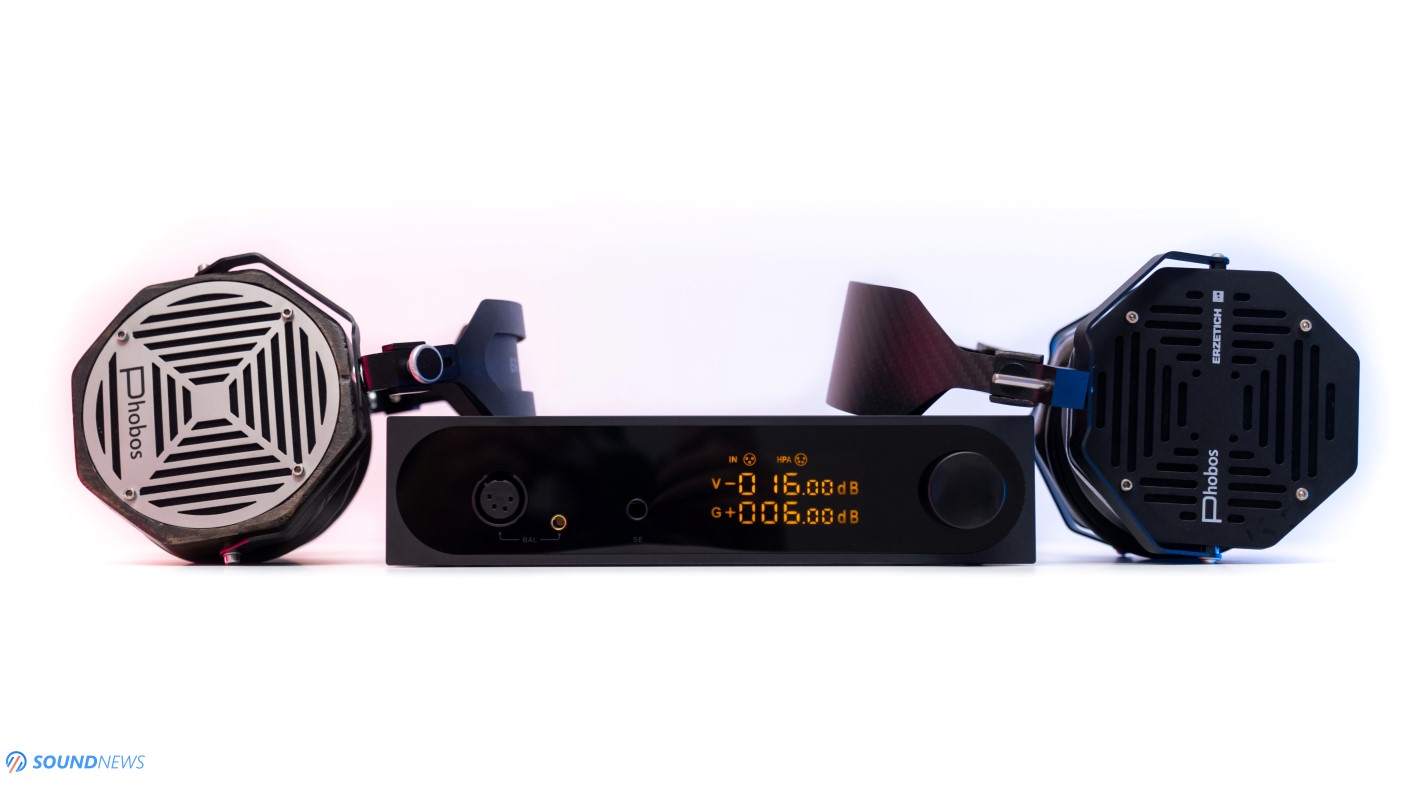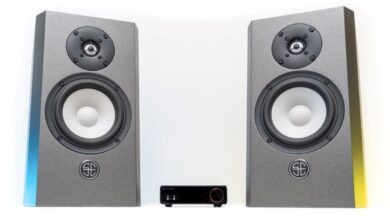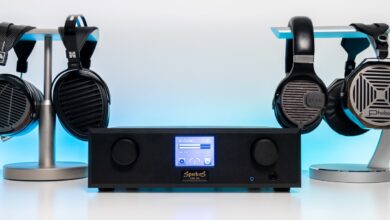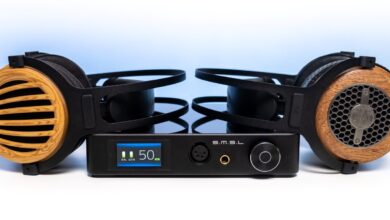Soncoz SGA1 Review – Wild Wild East
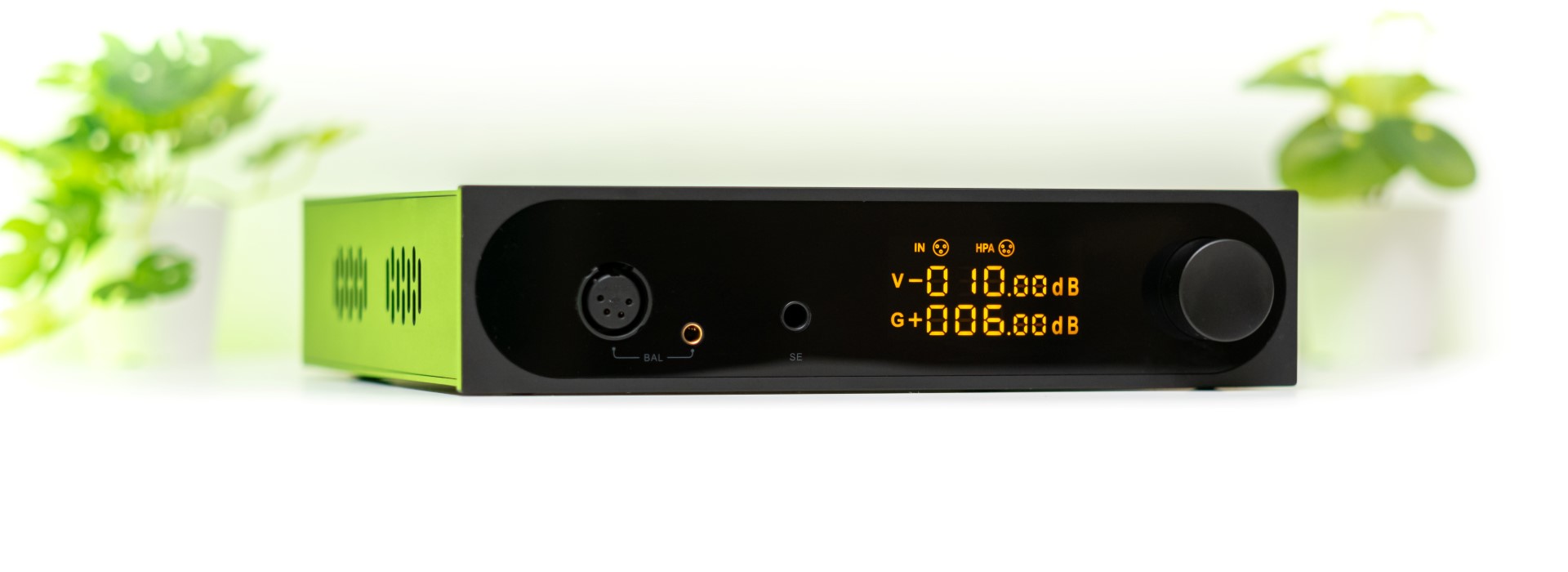
Soncoz Technology Co. Ltd. might look like a fresh and young company to you, but their lead engineers have years of practice, perfected in the digital and analog realms. After releasing several products under different brands, a time came for the big move that formed the Soncoz team as we know it today. They started small, but they learned fast, releasing two products in a short time frame and this feels only as a prelude to a much deeper story. Soncoz crafted their firstborns differently to other manufacturers, adding some of their own ideas and philosophy. To this day, their LA-QXD1 is still the most affordable fully balanced DAC money could buy, reinventing the true meaning of affordable Hi-Fi. Their SGD1 arrived at my front door as a storm, wiping the floor with entry to mid-level converters, that I had an urge to compare it with my flagship converter and that…should tell you something about it. Laying inside as much tech as possible, it impressed not only with excellent sonics, but with good looks and premium build quality.
Digital audio seems to be running deep through their veins, but there was something missing from their product portfolio, as not a single analog amplifier carried their name…up until recently when Soncoz announced their first headphone amplifier and preamplifier simply called SGA1. Designed as a matching amplifier for their top-dog converter, Soncoz again released their imagination, planting inside as much tech as possible. It features a fully balanced architecture, an advanced UI, a full set of unbalanced and balanced I/O, an overkill power supply design and filtering stage, protection circuits and a precise volume control, all wrapped in the same matte-black case. SGA1 goes for $650 and I’m genuinely excited doing an objective and comprehensive review driving a plethora of headphones, ranging from IEMs to desktop planar-magnetics, so let’s get it started!
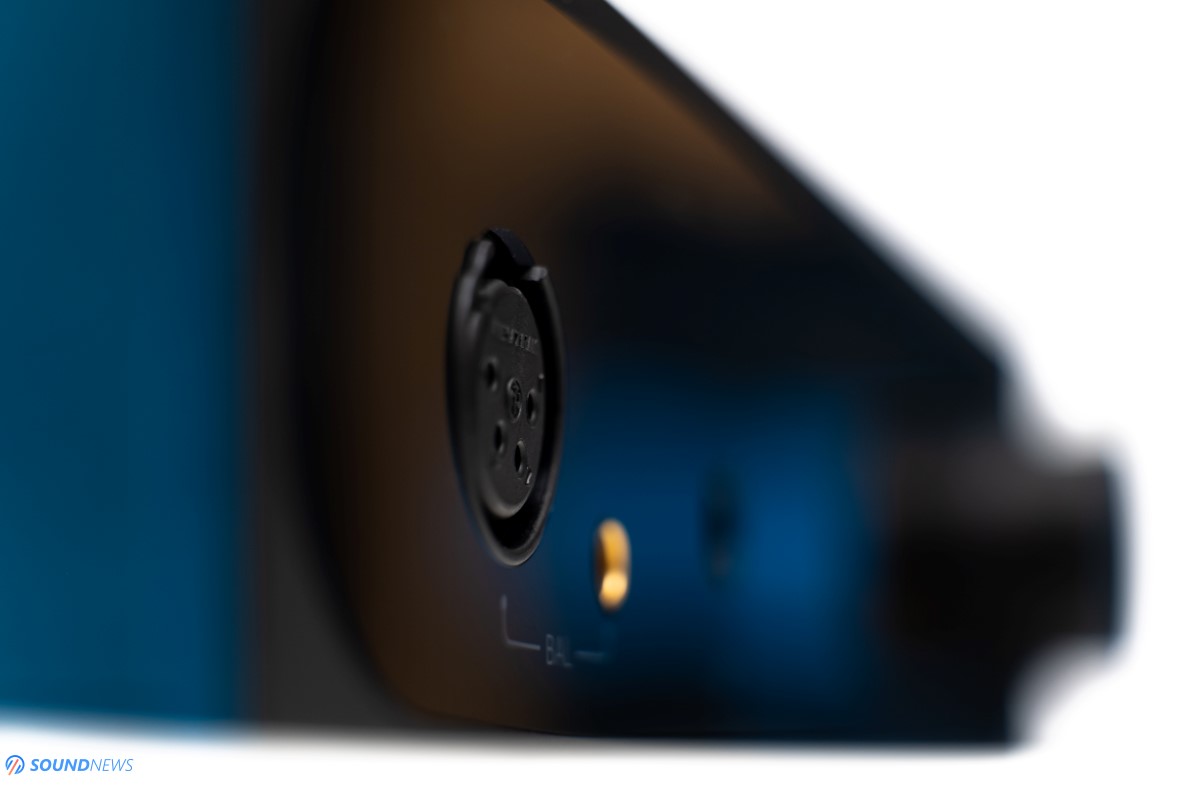
Unboxing & Package Contents
I am greeted with the same good old packaging that I’ve seen before. Its product box opens up like a book revealing the unit itself wrapped entirely with plenty of foam for a nicer protection. As expected, SGA1 has the same size and design cues with its matching DAC. I find it bigger to usual headphone amplifiers coming from Asia, adding some confidence that I’m dealing with a well-built unit. An accessory compartment will be holding a power cable, a small headphone adapter and a user manual. SGA1 can also be used as a preamplifier thanks to a pair of RCA and XLR outputs on its back, but you will need to manually adjust its volume as it doesn’t have a remote control.
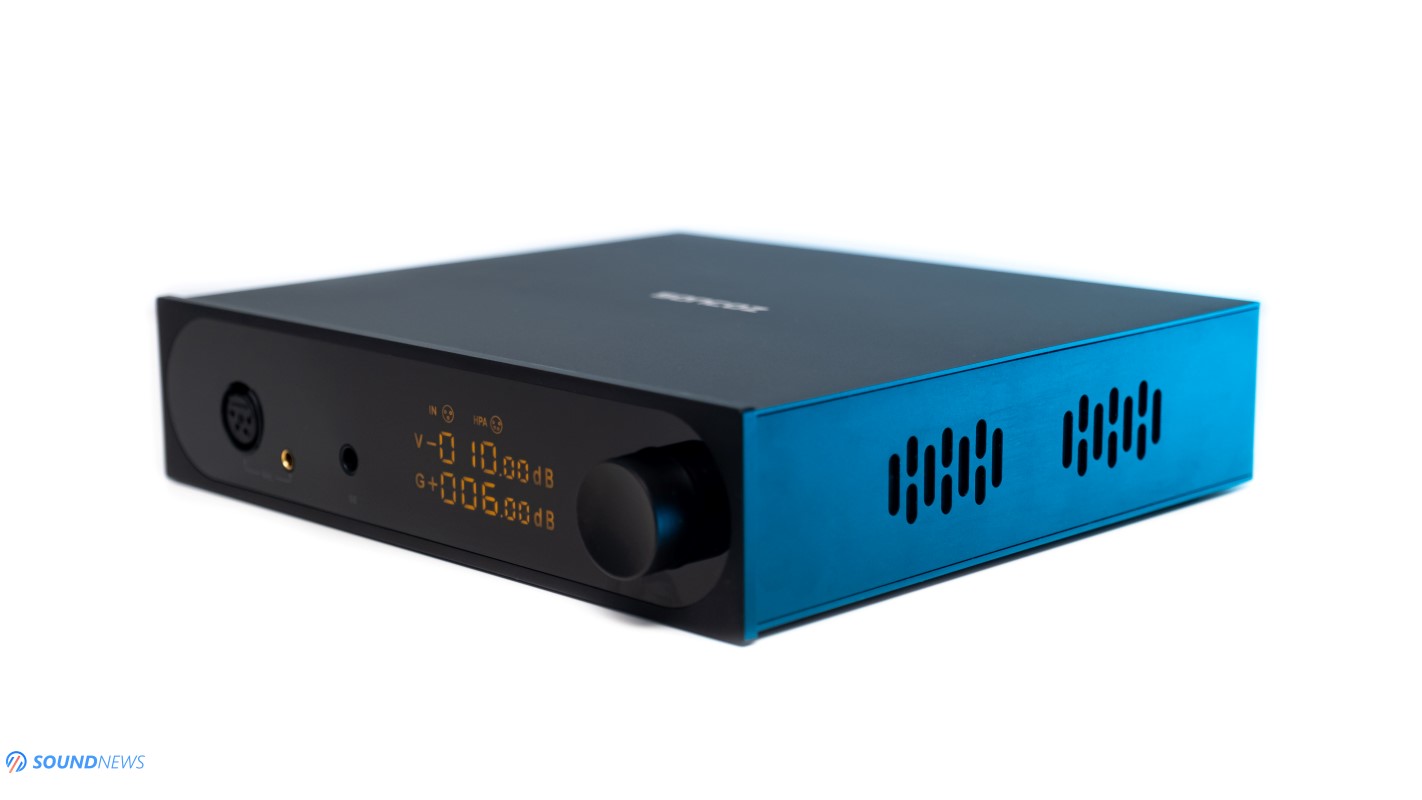
Design & Build Quality
As you can expect, SGA1 looks and feels exactly as their top-of-the-line SGD1 DAC and you can stack them together for a visually stunning combo. Forget about complicated UI’s or hidden menus that can be accessed only by a remote control, as I’m dealing with a clever and extremely user-friendly interface. Its monochrome screen will be showing the selected input, output, gain position and volume level and all that can be controlled via its volume wheel, that works as a menu navigator. I find it so simple, yet modern and exquisite looking.
Soncoz put ventilation holes under the unit and on its side panels, so that hot air would move away prolonging its life in the process. Instead of leaving an open area, where dust particles could get inside as it happens with plenty amplifiers of today (Hi Topping!), they added dust filters to counterbalance that issue – pretty clever if you ask me.
The only thing that I dislike about it are those short rubber feet that aren’t lifting it much from the table. In their stead, I would put longer ones (at least 4 times their actual length), for a nicer heat dissipation. In its stock form, it is almost touching the table, blocking the air intake.
As for its case, it’s a matte-black aluminum one milled on a CNC machine, with very tight tolerance numbers. All the screws were moved on its back panel for a clean and elegant look. Its front panel has a sheet of glass on top, they seem to care about its looks & build-quality and that can be felt immediately after closely inspecting the unit. Soncoz is offering it in two color options: matte-black everything (our review unit) or matte-gray, but fear not as both options aren’t attracting a lot of eyes. SGA1 has a simple metal brick-like design and I’m fine with that, as most of the Hi-Fi gear is looking this way.
At about 2 kilos or 4.4 pounds, SGA1 isn’t that heavy, but always gives an impression of a well-engineered and well-made product. From a big majority of DAC and headphone amplifier manufacturers coming out of Asia, Soncoz has definitely one of the best looks and form factor.
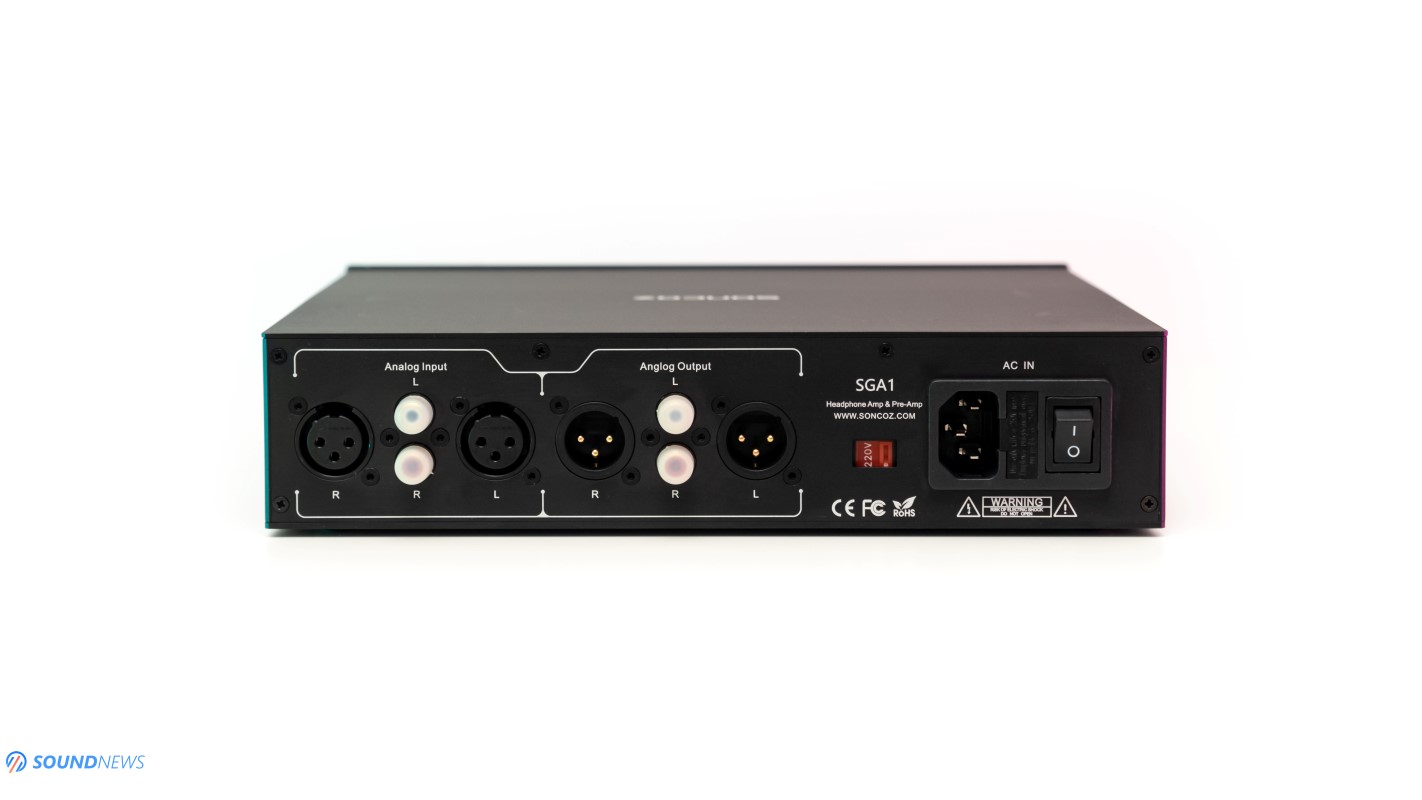
Controls & I/O
SGD1 has a clean looking front panel with just a volume knob to its right, a sheet of glass near it houses a monochrome screen and to its left a headphone jack trinity can be found coming in 4-pin XLR, 4.4mm Pentaconn and 6.35mm (1/4”) flavors.
On its back you’ll find an AC inlet, a voltage switch (100 V or 220V), an On/Off switch, two pairs of analog inputs and two pairs of analog outputs coming in single-ended and balanced options. SGA1 isn’t only a true balanced headphone amplifier, but also a balanced preamplifier and that’s pretty neat!
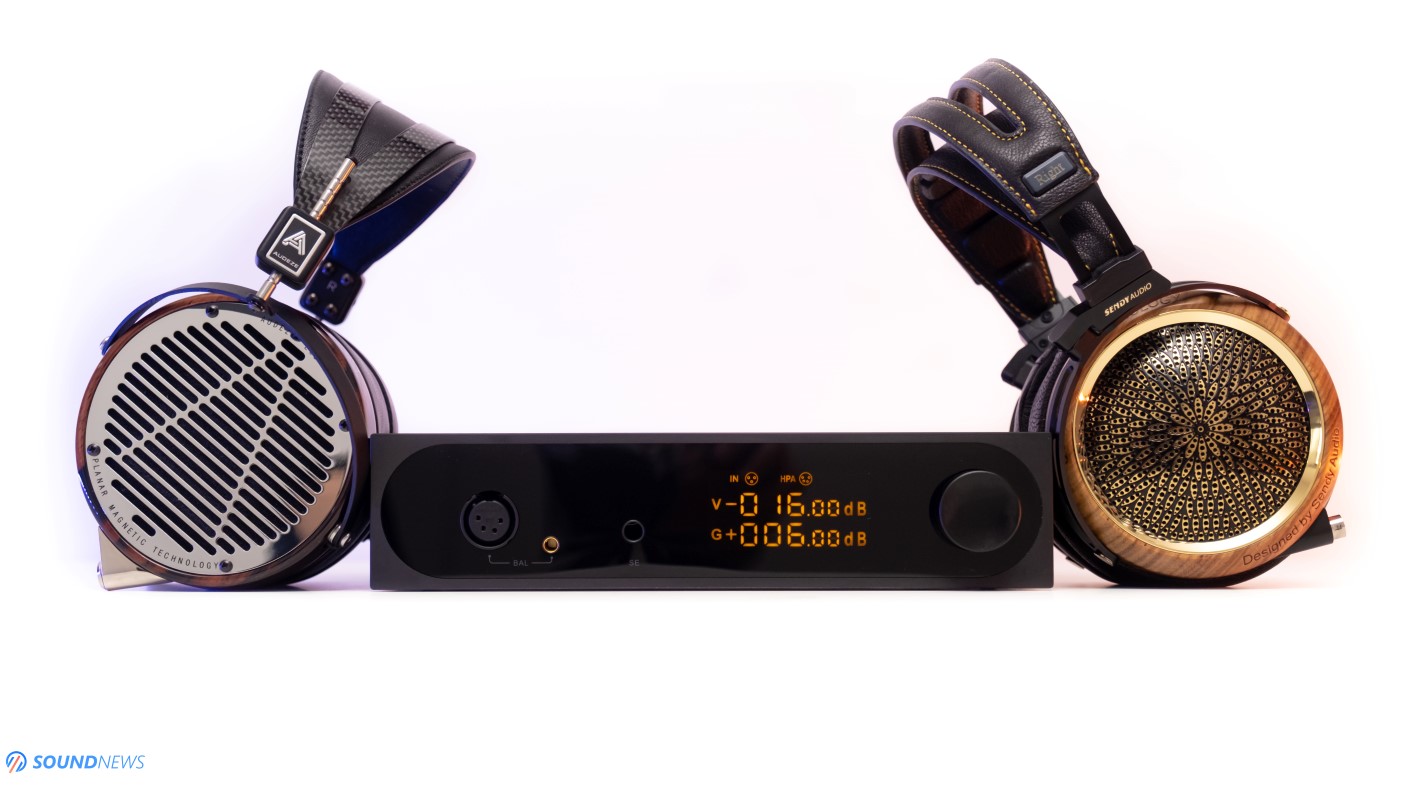
Tech Inside SGA1
As I’ve mentioned before, this is their first headphone amplifier that was designed to be used in a balanced configuration for the best results. We are dealing here with an amp that uses several OPA1611, OPA1641 and OPA1622 operational amplifier from Texas Instruments as voltage and current buffers, that are ensuring the basic operation of the SGA1. As for the OPA’s themselves, those are regarded as quite warm, smooth and natural sounding, exactly what an honest sounding DAC like SGD1 really needs.
It offers some 840 mW in 300 Ω and half that number in 33 and 600 Ω via its balanced outputs, regardless of its RCA or XLR inputs on the back. Via headphones, you can add up to 6 dB of gain and up to 7 dB of gain if it works as a preamplifier. I’m glad that Soncoz left is low-gain setting at unity gain (0 dB) as that’s the best setting for IEMs and sensitive headphones. While on paper it doesn’t seem to offer unlimited power, its high-gain setting of 6 dB should be more than enough for harder to drive headphones.
By far, the most interesting part about SGA1 is its power supply design. It uses a custom-made toroidal transformer that is encapsulated with permalloy, shielding it from sensitive analog circuitry. If that doesn’t sound like enough, to further suppress the 50 Hz and 60 Hz noise, they’ve added a layer of magnetic stainless-steel baffle that works as a secondary line of defense, stopping all remaining noise and acting as a passive power conditioner in the process.
The absolute last line of defense is formed by a bunch of analog relays that can save your precious headphones from pops and crackles. Alright guys, I’m ready for some well-deserved music, so let’s hit some ear-drums!
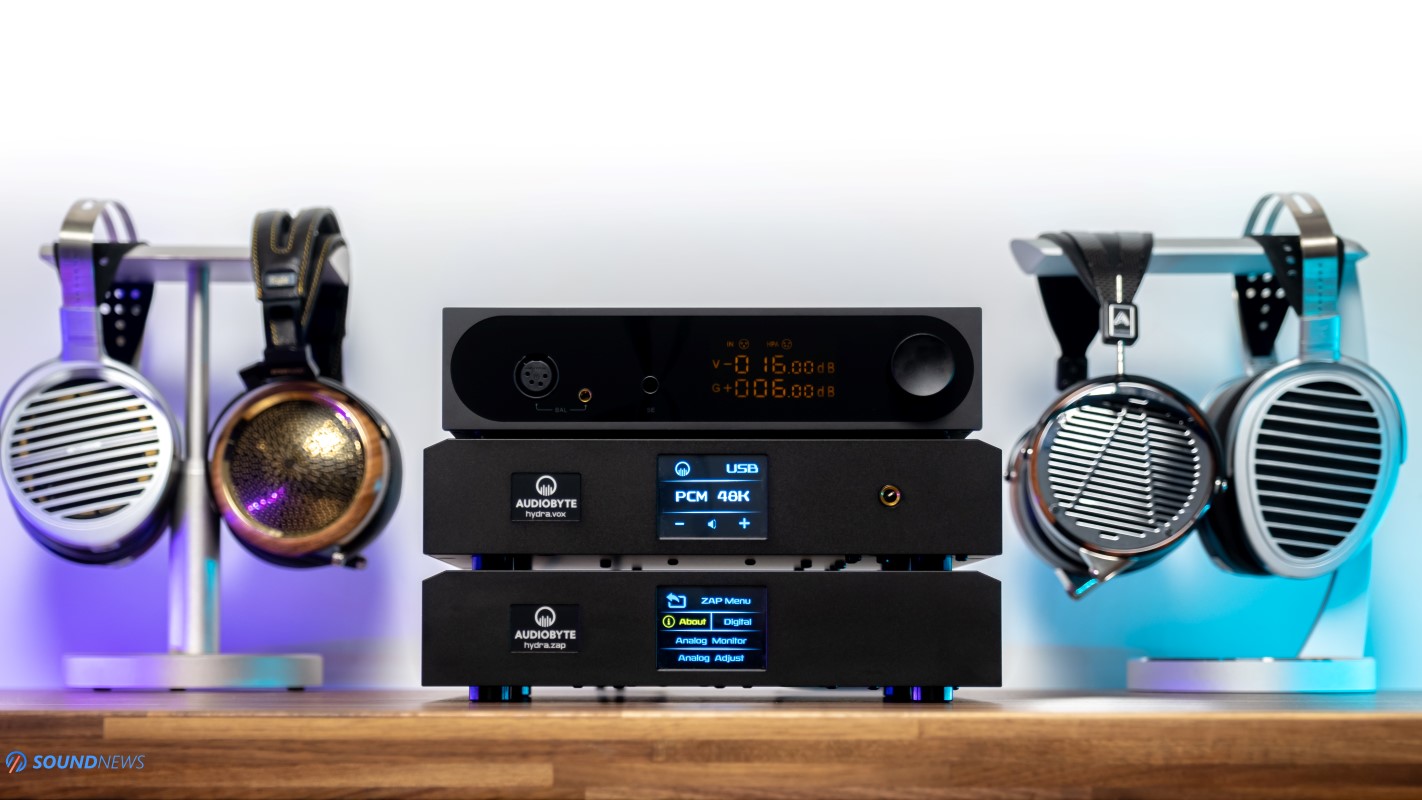
Test Equipment
I wanted to unleash its truest potential, so it was mandatory using it with several high-end D/A converters. I also wanted to check how it performs with a weaker signal via XLR like 3.8V instead of the industry standard 4V and subsequently how it performs with higher voltages like 5V and 6V and that is why it was connected to an Audiobyte HydraVox and then to a Matrix Audio Element X. I consider them as some of the finest D/A converters and I am pretty sure that I will be squeezing the last drop of performance out of SGA1.
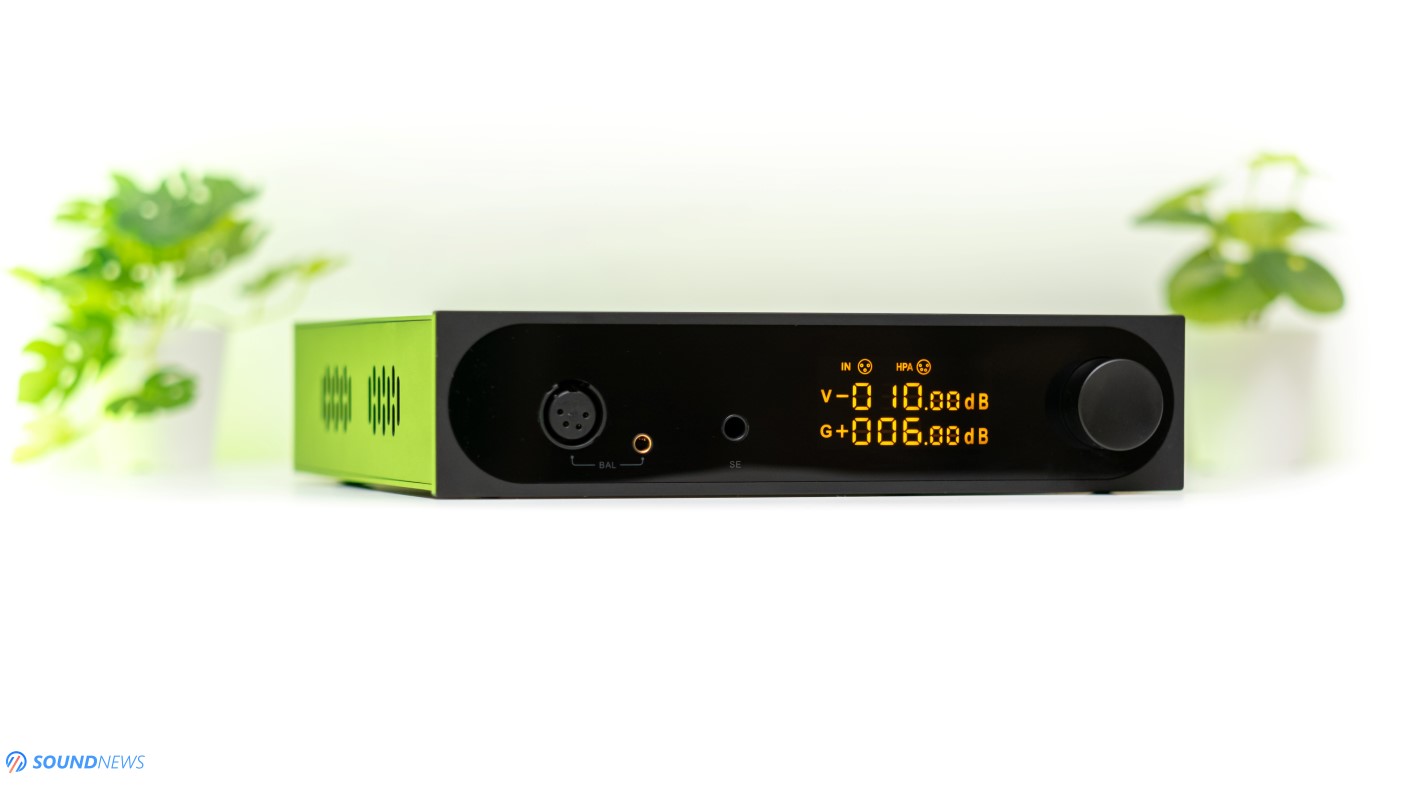
Sound Performance
I. Preliminary Sound Impressions
The sound of chip-based amplifiers is well known to me and to this day, the best measuring headphone amplifiers are still using op-amps and not discrete components…how curious. I have op-amps in a lot of headphone amps: Benchmark HPA4 ($3000) is full of them, Topping A90 and A30 PRO are also using op-amps as their driving force. NFCA modules of Topping, PLFC modules of SMSL and AAA modules of THX are using op-amps and those are still unbeatable when it comes to high SNR and super-low THD numbers. With all that said…when putting my headphones on, something was missing with such amplifiers and it’s difficult putting a finger on what that was, explaining with mere words without taking a listen isn’t that easy. Something wasn’t clicking into place, making my tunes ruler flat, barely transmitting emotions or making me move to the rhythm of the music, but that is going to change with the amplifier that I’m testing today. Soncoz went with a dozen of OPA’s from Texas Instruments, but they had a different philosophy to everything that surrounds them, starting with power supply and noise suppression and then finishing with the filtering stages, Soncoz put their bright minds in delivering something else, something that wasn’t rushed, but made with dedication and care.
Switching mode power supplies of the former devices that were mentioned above were replaced with a custom toroidal transformer, encapsulated with permalloy, shielding the analog circuitry from any wireless interference. A stainless-steel baffle design was put as a secondary line of defense, killing all remaining noise for good. That’s really something else folks, I’m already impressed! Lastly, a variety of linear regulators and rectifier circuits were carefully selected for an ultra-low noise power delivery to its key analog circuits, ensuring excellent performance even out of ordinary op-amps found in most amplifiers of today.
All those things combined, transformed an op-amp based amplifier into something that doesn’t sound like one, reminding a whole lot more about all-discrete, transistor-based amplifiers that were biased into Class-A operation. This isn’t an exaggeration from my part, not a slightest, as SGA1 was able to awake emotions in my music and made me feel good, it made me toe-tap, stopping from whatever I was doing in front of my PC. It captured my attention with a powerful low-end delivery, with a fuller-midrange and with and soul-grabbing vocal performance. I find it honest and detail-oriented, very much in line with the latest releases from Asia, but it wasn’t an extremely linear or flat sounding unit. There is definitely something happening in the bass and midrange regions, while adding a smoothing filter in the top-octave. It is quite unusual writing all this, knowing its voltage and current buffering stages, but once again Soncoz proved that the most important part of all analog designs is the power supply and noise suppression mechanics, that an dismantle grain and traces of digitus & listening fatigue. There is definitely some of that boldness and impact down-low, there is a nicer saturation in the midrange that improved the vocal performance and I never experienced listening fatigue in a two-week period. SGA1 reminds a lot about their SGD1 DAC that I’ve reviewed some time ago, that didn’t follow the same road paved by ESS-Sabre converters, by adding plenty of warmth, relaxing the top-octave and the shimmering. SGA1 is very much the same and it would never remind about the sound of THX-AAA, NFCA or PLFC designs, that I am getting bored of as of late.
Exchanging DACs with the SGA1 on top, made me realize that I’m dealing with a clean sounding unit that would never stay in front of the musical signal. No matter if it was the Audiobyte HydraVox, the Matrix Audio Element X or the the SMSL D1SE, it wasn’t staining their tonality, leaving their mark unchanged, adding just a bit of smoothness and soul into music. In all seriousness, it wasn’t making my headphones bright or harsh sounding, even entry-level Hifiman headphones sounded organic, teleporting treble ringing and glare into a distant past, preserving cleanness and detail-oriented nature of higher-end headphones. SGA1 doesn’t seem like another headphone amplifier coming out of China, this is something else entirely that cares about the final outcome, transmitting a clear message and imbuing your music with positive emotions. That’s a hell of a first impressions lads, but let’s carry on and try a bunch of headphones.

II. Power Output
There’s a big paradox with the SGA1, while on paper I’m looking at an amplifier that can’t provide a single watt of power on its balanced outputs, it was sounding brave and mean with most of my headphones, always leaving a ton of headroom on tap. Before I move on further with my review, here’s a small advice to you: if you get it, please add 6 dB of gain immediately after powering it on and never touch its gain position, ever again. On paper it provides around 840 mW in 300 Ohms and half that power into 33 or 600 Ohms via balanced outputs. It is clear to me that it caters more to higher-impedance headphones than to low-impedance and low-sensitivity ones, as certain planar-magnetic behemoths.
Going by a (silly) rule of thumb that most planar-magnetics need a least a few watts of power to be moved and controlled, then SGA1 can’t possible do that and it should be shy and unimpressive with most of them, right? That’s wrong! Be them desktop dynamic headphones or low-sensitivity ones, SGA1 didn’t pose a slightest problem with them al. It was still controlling those drivers, it was still pumping dynamics even with harder loads as Hifiman HE1000SE, Audeze LCD-4 and Sendy Peacock. LCD-4 is a huge burden for most affordable amplifiers and yet, with 16 dB of volume remaining on tap, leaving enough headroom behind, LCD-4 were sounding exactly as I know them with my upper-class amplifiers. Even reference recordings with a DR of -14dB didn’t pose a problem to the Soncoz unit and LCD-4 were still highly engaging and toe-tapping all the time. Honestly, from my growing headphone collection, LCD-4 sounded the absolute best, just amazing and extremely engaging, a thing I wouldn’t say about most amplifiers in this price range. I’m not sure if their 200 Ohm impedance plays a major role – a region where SGA1 would provide considerably more power, but I couldn’t stop smiling and air guitaring when the Soncoz amp was driving them. Treble oriented headphones as Hifiman HE1000SE were also spectacular with it, as it was able to infuse just a small dose of dopamine in the midrange, while calming down the treble grittiness and listening fatigue. HE1000SE sounded as if I magically shrunk that Flux Labs Acoustics Volot ($2550) into a smaller case and left its voicing untouched, it made them alive sounding and a lot more manageable in long listening sessions. This was an amazing pairing that I wouldn’t forget very soon.
I tried sending it into the clipping territory with the Matrix Audio Element X that could pump up to 15V of pure analog gain on its XLR outputs and interestingly enough, SGA1 scaled impressively well. It performed a little better with a hotter signal of 5V via XLR that boosted SGA1 power by a little, helping with difficult loads as Hifiman Susvara.
Susvara didn’t sound bad at all, dynamics were decent, but not outstanding and it was clear to me that SGA1 can’t pull the best out of them. It was unusual hearing them alive with such a demanding load, it wasn’t shutting down and it wasn’t clipping at higher volumes. However, little to no headroom remained on tap, limiting dynamics with higher-dynamic range albums from labels as 2L, Linn, Blue Note, Chesky, Deutsche Grammophon, StockFisch and Reference Recordings. While a 5V output from my DACs helped it a little, I was still maxed out with Susvara on several occasions and that wasn’t enough power to put the SGA1 on the map of Susvara approved amplifiers. On the merry side, every other headphone was fully driven and tightly controlled down the lowest pits of sub-bass. For a growing headphone collection, SGA1 looks like a fine solid-state amplifier
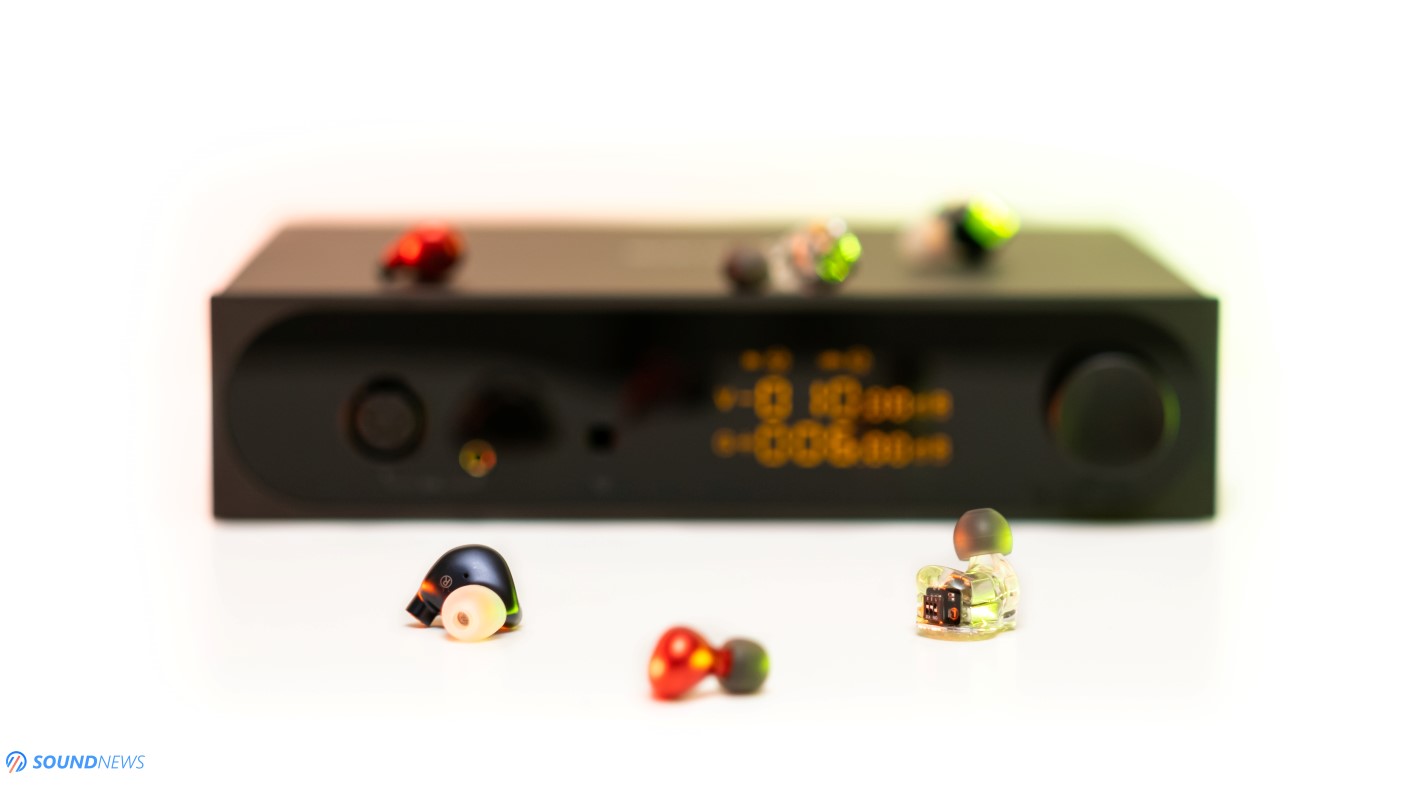
III. Noise Floor
Can you guess why I’ve recommended adding 6 dB of gain (its maximum gain setting) and never touch its gain settings ever again? You’ve guessed it: we are dealing with a silent amplifier that could be used with IEMs even on its highest gain. I didn’t expect less with a measured noise floor of 1.8 micro-Volts on its SE output and double that number on its balanced outputs. That’s a very low noise-floor, not exactly world-class performance as there are several units that were more impressive in here, but I can’t deny its clean and undistorted nature with anything attached to it, including sensitive IEMs.
I really like the newest generation desktop headphone amps that are engineered to work well with sensitive loads as IEMs or portable over-ear headphones. I personally don’t use them at home, only on the go, but only thinking that every single one would receive clean and undistorted power at all times, makes me a lot happier. What’s more impressive is that I’m dealing with their first amplifier and it’s already impressive as far as noise floor goes.
It makes sense now why they went with an overkill power supply, with noise-suppressing and filtering stages, because all that paid off big time and I couldn’t detect disturbing noises whatsoever with the most sensitive IEMs I have in my possession. I’ve tried a few more IEMs and it offered a pitch-black background and a noiseless performance even at higher SPL. I even compared it with a noise-killer champion: the mighty Benchmark HPA4 and sure enough, SGA1 was a tiny bit noisier at maximum volume and that is an outstanding result, considering that it costs ~4.6 times cheaper than the HPA4. Of course, nobody can listen at that volume, that amount of power would damage the IEMs and my ear-drums in a split second, so again great results in both cases. Only close to its maximum power, there was a faint white noise hidden in the background that can be considered as normal behavior. At normal listening levels, you can happily drive highest sensitivity IEMs on high gain and you’ll get the same outstanding results.
Any other IEM, portable over-ear and sensitive desktop headphone performed very similar and couldn’t pick its noise floor at my usual listening levels.
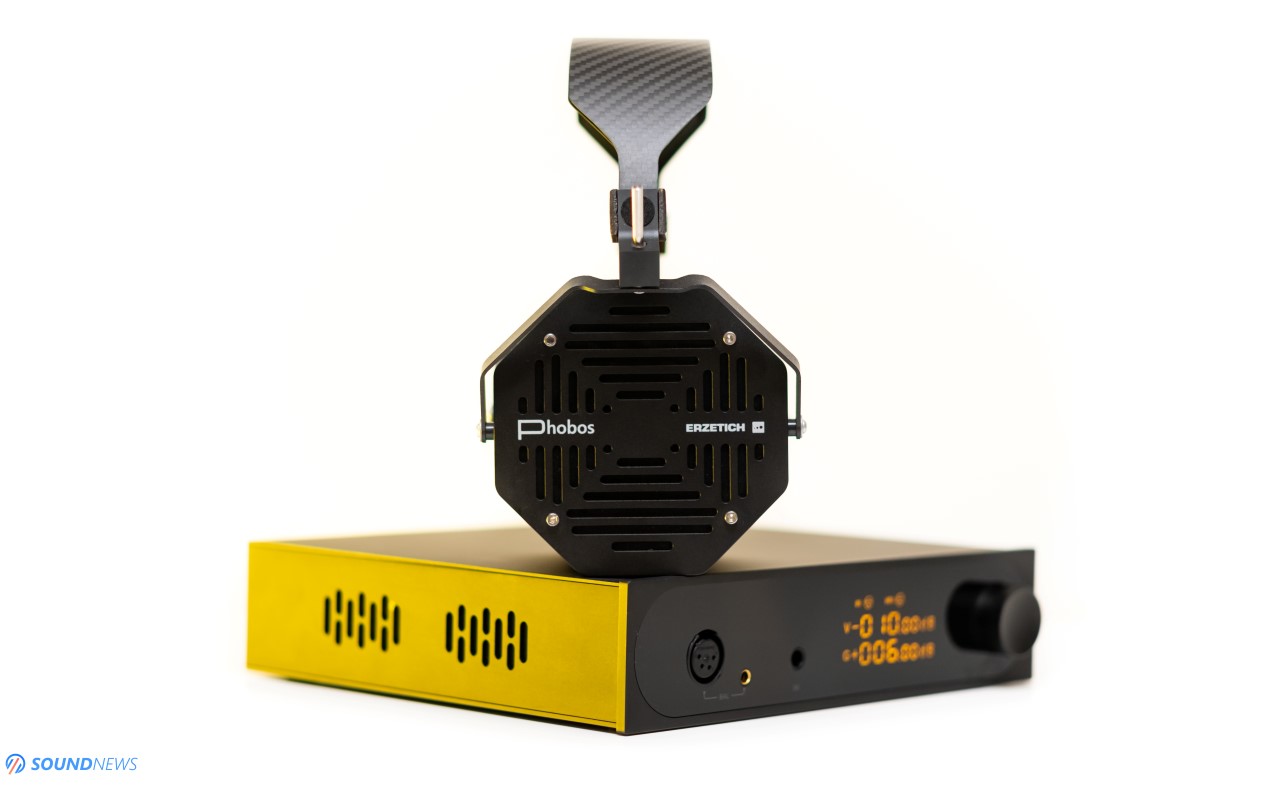
IV. Resolution & Transparency
It seems that Soncoz focused their efforts in delivering a clean sounding amplifier that wouldn’t lower signal-to-noise ratio and the fruits of their labor are speaking for themselves. SGA1 is putting a mild accent on detail-retrieval, always wanting to deliver a higher transparency to usual op-amp based amplifiers. While it won’t challenge the best measuring amplifiers out there as Benchmark HPA4 or Topping A90, it still sounds resolving and close to the source material that is being played. Put it on a highly detailed DAC and immediately some low-intensity notes would spring in the most unusual places, like mushrooms after a rain. Even if it didn’t highlight the leading edges as much as THX-AAA and NFCA amplifiers did, there wasn’t a moment when I felt that something was missing from my music. Using a nice volume control as Muses 72320 of New Radio Japan that you can spot in several preamplifiers of today and non-polar coupling capacitors, Soncoz was able to pull-out the last drop of performance from those OPA operational amplifiers, showing a tour de force in a few key areas, including detail-retrieval.
When it was driving the mighty Susvara, it delivered clean sonics in a very transparent way, never downgrading their resolute-nature and never lowering their technicalities. Going through a huge music collection, covering a wide range of musical genres, I can safely say that SGA1 chooses a see-through transparency and a high resolution even past top-octave. Did I hear additional micro-details compared to something like a Musician Andromeda, Gustard H16 and to smaller units like xDuoo XA-10? Sure, I did and all that was presented in a very relaxed and non-aggressive way. While being extremely textured and clean, its top-end was never bothering or dry sounding. There is no point of going through a few tracks just to arrive at the same conclusion that SGA1 is ultimately a clean and transparent sounding amplifier to its core. For a chip-based amplifier that is a little unusual, but considering all the care that went into its power supply and filtering, it all makes sense now.
Another interesting trait is that while being clean and detailed at all times, it never forced me looking at those details. Snare drum hits and cymbal crashes stood out with their natural metallic bodies, without adding unwanted ringing and shrillness that several amplifiers are putting on a plate.
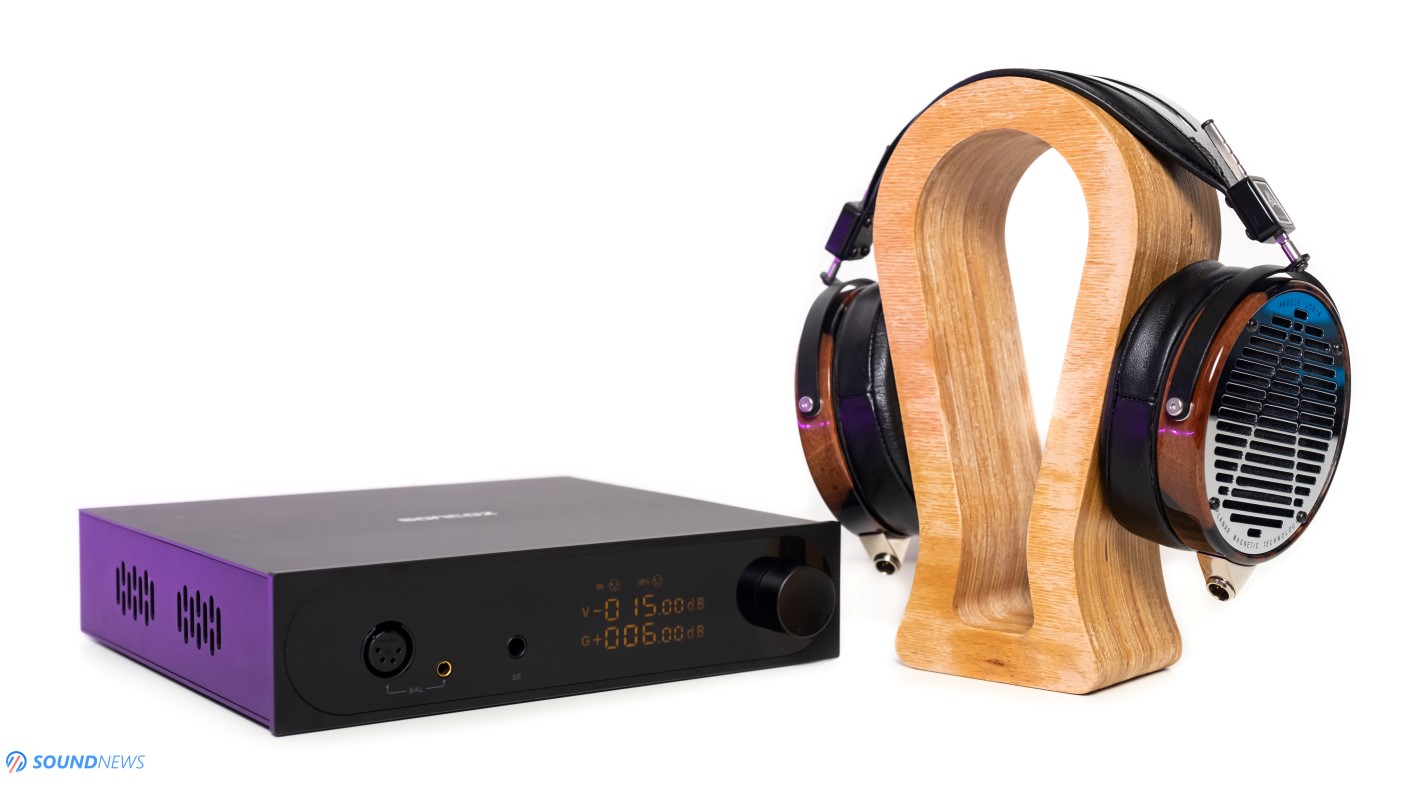
V. Transient Response
Generally speaking, chip-based amplifiers are impressive when it comes to speed and fast decays, thanks to their wide bandwidth working principle, but they aren’t exceptional when it comes to landing serious punches into the eardrums. Look at the latest generation op-amp based amplifiers of Topping, SMSL and Gustard, those are always pressing down the gas pedal, going in and out like Speedy Gonzales, but they aren’t as mean and impactful down low as transistor-based Class-A amplifiers are doing so easily and gracefully. There is a reason I’m hopping lately into the all-discrete amp bandwagon, as I believe those could deliver nicer dynamics, fully unlocking the potential of your headphones.
Soncoz knows all this and that’s precisely why an important decision was made to never use a SMPS (switching mode power supply) in their SG series, that are sitting in a lot of devices I’ve mentioned above. Going with a custom-tailored and fully-shielded transformer, something scary awakened from a deep sleep. With SGA1 bass is going deep, sending tremors towards headphone diaphragms and a clear message to the listener. While, I’ve heard a nicer bass slam in price-no-object amplifiers, I don’t recall feeling it as physical at ~$650. SGA1 is always trying to lift your mood, with its powerful bass delivery and engaging approach to music reproduction. This is not a ruler flat and linear sounding amplifier, there is definitely a little more oomph down low and more meat in the middle-frequencies. Hell, I find it more engaging even to that all-discrete Singxer SA-1, don’t ask me why that is happening, it is just more imposing and lively sounding to me.
Audeze LCD-4 and Hifiman HE1000SE were mating with SGA1 as Ying does with Yang, taking all their pluses and adding some flavor into the mix. Add faster decays and you can almost imagine that it kept up with a rising tempo and it was propelling those bass notes back and forth like a machine gun, easily passing my transient response tests with high marks.
There’s one good thing that was clear from the start, it mates well with all my digital sources and its impactful and lively sound signature would always carry over. No matter if you’re using entry or high-end converters, it would always deliver a nicer impact down low.
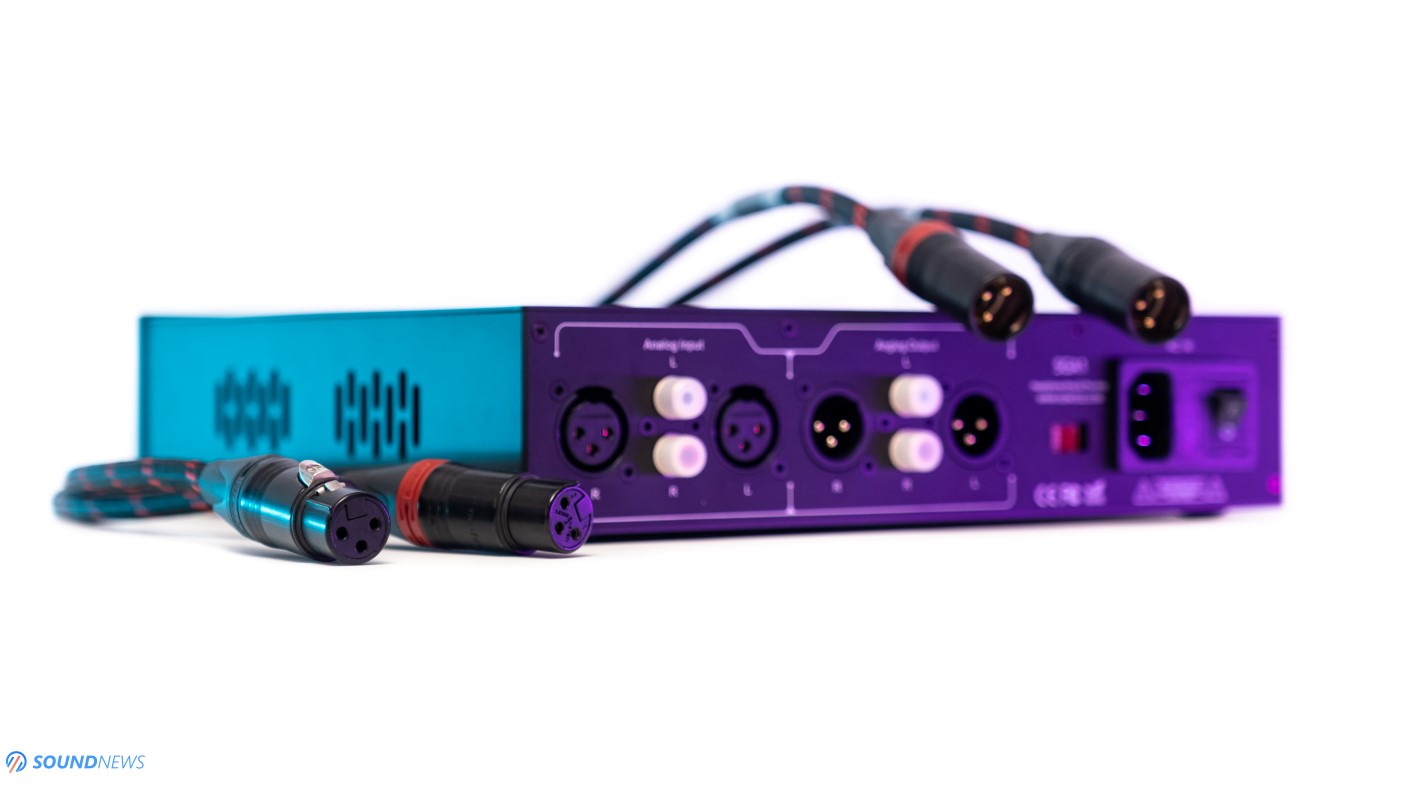
VI. Soundstage & Depth
If I would nitpick a little about the SGA1, then that would be surely about its power output and then about its medium-sized soundstage on all axes. After experiencing a dozen of headphone amplifiers, I could safely say that output power directly influences the sheer scale of the music. The same unwritten rule applies to loudspeaker setups, as in my case powerful dual-mono configurations delivered the widest and the most believable stage size. Our unit right here is a little shy when it comes to power output, as I wasn’t feeling that my head is completely surrounded by music. Sure enough, reference recordings were pushing all that wizardry outside my head, adding a much-needed air in between the notes, but all that wasn’t as impressive as higher priced amplifiers were doing.
While it wouldn’t outperform the likes of Flux Lab Acoustics FA-10 ($750) and Burson Soloist 3X ($1200) in terms of scale, it outplayed several chip-based amplifiers like Topping A90 ($500), SMSL SP400 ($630) and Musician Andromeda ($870), so there is still a decently sized soundstage and a pretty good depth. Due to its clean and detailed sounding nature, without adding any noise into the system, pin-point location of all the notes around me felt precise and I could easily focus on anything in particular. There are thousands of tracks that carry tens of instruments, from which a single one could steal my heart and with such music it was extremely easy focusing on that particular instrument, without closing my eyes. It scored another point when I was digging deep into my music, I could easily appreciate the distance between every musical note and myself, leading towards an outstanding depth. It seems that it will not artificially boost the soundstage size, as it might happen with few tube amplifiers and it will render all that information as close as possible to the original intent of the mastering engineer. It sounds slightly bigger, wider and taller with live music and the other way around with cozy blues and jazz recordings.
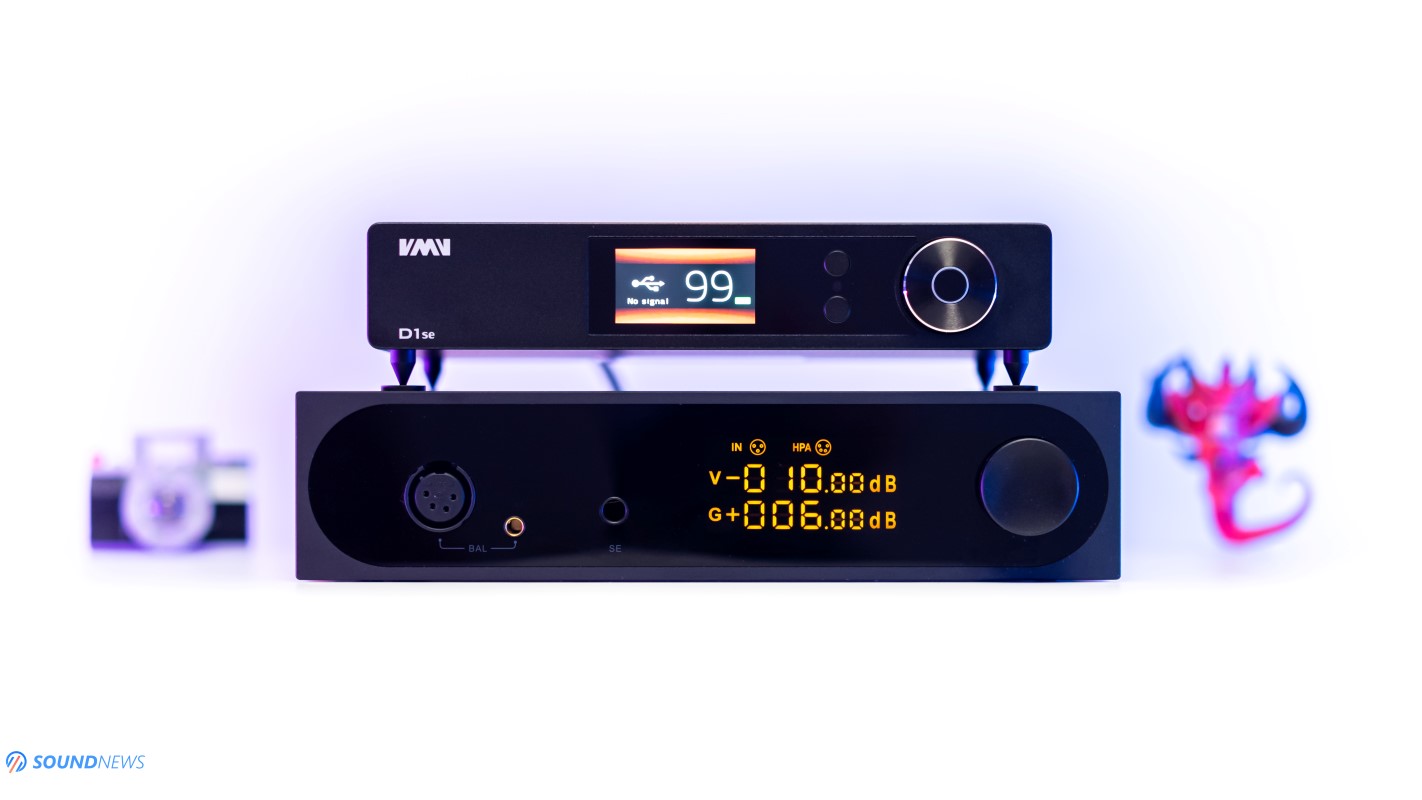
VII. Frequency Response
SGA1 is a wide-bandwidth amplifier, covering the frequency response in full. While it adds some texture and weight in its low and mid-regions, its frequency response feels straight as a line, as everything seems to play at the same SPL.
A. Bass
It seems to use a special recipe when rendering bass notes, starting with the lowest octaves. When I’ve heard some outstanding bass lines with the Susvara, it was clear that I’ll have the same results with any other headphone. There is a good extension down-low, a controlled sustain and a natural decay of the bass. It never lingered for a micro-second longer, it was always on time, precise, fast and impactful sounding. Weight and fullness would be nothing without air, layering and cleanness, luckily, I find its low-end clean and completely noise-free. Low-intensity notes have enough air and are never slipping over the midrange area. This is a high-quality type of bass that I wish all chip-based amplifiers would have. Mid-bass felt exactly as powerful and bold, adding a higher density and a sense of fullness all the time.
B. Midrange
One of the biggest highlights of SGA1 is that it never sounded dry or thin in the midrange, on the contrary it added more energy in there, creating a believable and a soothing vocal performance. My folk, blues, jazz and rock collections sounded alive and quite natural, exactly as I know them to sound on all-discrete amplifiers. Soncoz added just a pitch of warmth and naturalness that popped its midrange, pushing it closer towards the listener. It was a paradox, as some of my older recordings appeared detailed, but also organic and alive, usually it’s one of the other. In the end, I wouldn’t describe it as overly warm or overly dense sounding unit, it was more about being honest, while fully preserving the weight, the innards and the naturalness of the midrange. Going slightly higher on its volume didn’t make it aggressive, it was still cruising around, adding smoothness and a sense of calm.
C. Treble
Another interesting aspect is that no matter the song I would listen to, it wouldn’t make it harsh with bright tilted headphones as Hifiman creations. Treble felt highly detailed and precise, unfolding everything past top-octave without too much trouble. Double drums were fast, clear and defined, snare drum hits were impactful and tambourines were metallic sounding, but never bothering. My rock and metal tunes didn’t pose a slightest problem even with the Hifiman HE1000SE on my head. The usual grain and over-sharpness of several THX-AAA amplifiers was forever gone, never to be spotted on the SGA1. It tamed their hot treble, while preserving its detailed and clean performance.
Overall, I wouldn’t describe it as warm, thick, bright, lean or mellow sounding. I would describe it as natural sounding, true to the recordings, linear and extended in the frequency response, covering it in full.
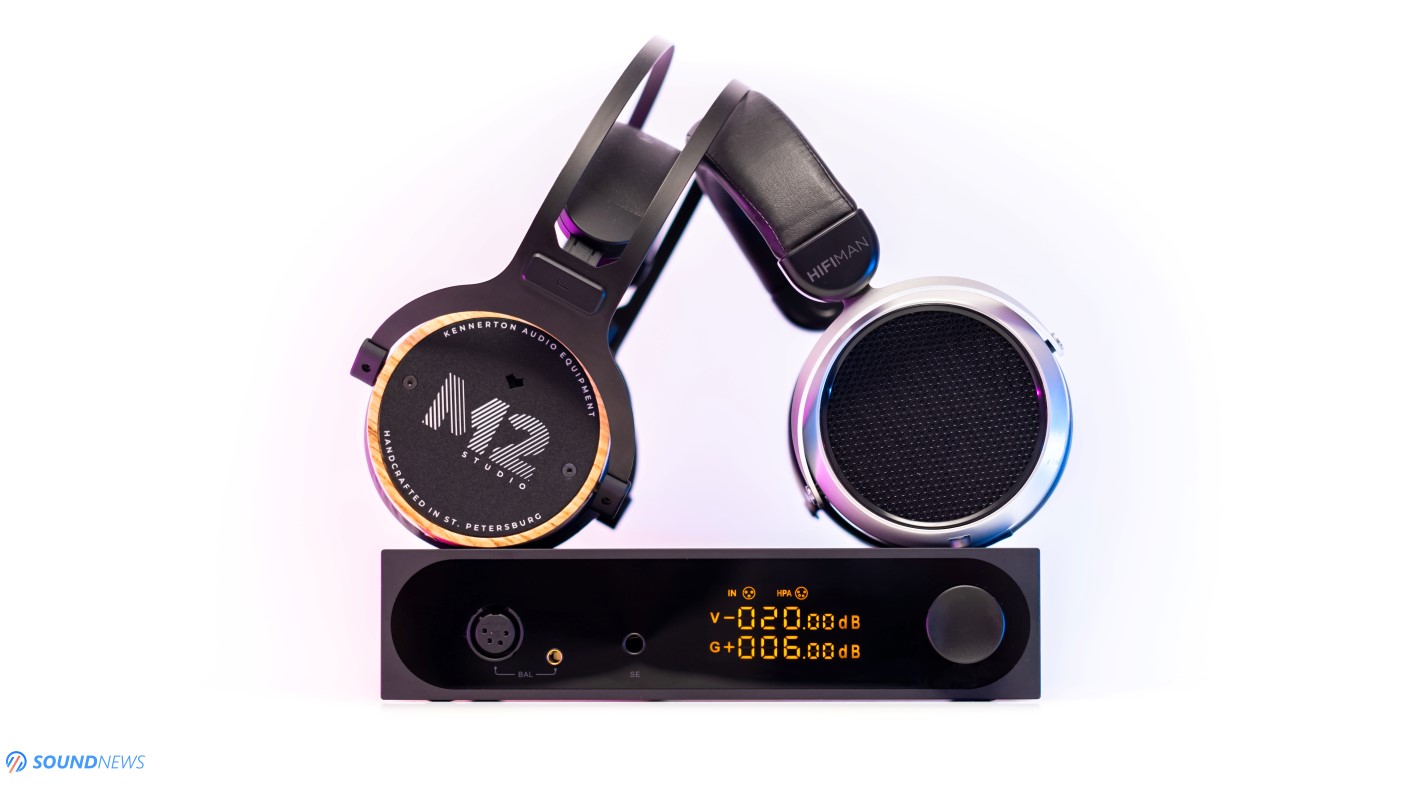
My Conclusion
Considering it’s the very first amplifier made by a company that worked only with digital audio before, I am beyond impressed by the final outcome! Soncoz proved that not all chip-based amplifiers are sounding achromatic, lean or boring. Its overly engineered power supply and filtering stages paid off big time, improving its timing, adding weight and fullness and dropping its noise floor into the abyss. SGA1 is an outstanding proposition for people that use multiple headphones on a daily basis. Be them overly sensitive IEMs or heady-duty planars, it drove them all preserving their unique character, while adding a pinch of naturalness into the mix.
It’s built to very high standard, fit and finish is excellent and I find its display simple, yet clever. Lacking a remote control, I couldn’t test it in a loudspeaker environment, but I can only presume that its natural tonality would carry over.
Besides its limited soundstage size and power output with some of the heaviest loads, everything else was right up my alley, offering plenty of technicalities, while preserving the liquidity and soul of the music. It worked exceptionally well with brighter headphones, smoothing-out their leading edges and boosting their tonality. It paired outstanding with Audeze and Hifiman headphones and it should perform very similar with dynamic diaphragms. All things considered; it’s asking price of $650 is fully justified. It scored a Silver Award and I cannot wait to find out what’s coming next.

Soncoz SGA1 was kindly provided by HiFiGo and it can be purchased from their web-store by following this link. They are selling it world-wide and it will be sent from the nearest warehouse to your location to avoid additional fees. In case you get one, leave some feedback below, I’m curious to know how it performs in your setup. 😉
PROS:
- Simple, yet elegant looking device
- Top-notch build-quality
- Easy to use UI
- Warmish tonality, natural sounding at all times
- Clean, transparent and highly resolving
- Noise-floor is always in check, IEM friendly
- Excellent dynamics, including pace, rhythm and timing
- No dips and no rises in the frequency response
- Mostly rich and full-bodied
- Good depth and pin-point location of the notes
- Wide selection of inputs and outputs
- A good value
CONS:
- Limited sound staging capabilities
- Not the most impressive power output
- Lacks a remote-control to be used as a preamplifier
- Some taller feet would be nice to have
ASSOCIATED EQUIPMENT:
- DACs: Audiobyte HydraVox & HydraZap, Matrix Audio Element X, Gold Note DS-10 Plus & PSU-10 Evo, Musician Aquarius, Topping D90SE, SMSL D1SE
- DAPs: FiiO M11 Plus LTD, M15, Shanling M8, M6 V21
- Headphone Amps: Soncoz SGA1, Flux Lab Acoustics Volot, Benchmark HPA4, Burson Soloist 3X, Musician Andromeda, SMSL SP400, Topping A90, Gustard H16
- Preamps: Musician Monoceros, Benchmark HPA4, Topping PRE90
- Power Amps: Benchmark AHB2 (x2), KECES S300, SMSL SA400, Burson Timekeeper 3i
- Loudspeakers: KEF Reference 3, Natural Sound NS-17, Sound of Eden Crescendo UNO
- IEMs: FiiO FA9, FH7, FH5S, FD7, Meze Rai Penta, Rai Solo, LittleDot Cu KIS, Hiby Crystal 6 & others
- Portable headphones: Sennheiser Momentum 2, Meze 99 Classics, Sony WH1000-XM4
- Full-sized headphones: Hifiman Susvara, HE1000SE, Arya, HE400SE, Audeze LCD-4, Erzetich Phobos 2021, Erzetich Mania, Kennerton Wodan, Magni, Gjallarhorn, Vali, M12S, Ollo S4X Reference, Apos Caspian, Sendy Peacock & Aiva
- Interconnects: QED Reference (x2), Topping TCX1 (x2)
- Speaker cables: Kimber PR8, Audioquest Type4
- Power Cables: Isotek EVO3 Premier (x3)
- Balanced Isolation Power Conditioners: PLiXiR Elite BAC1500 (stereo setup), Elite BAC400 (headphone setup)
